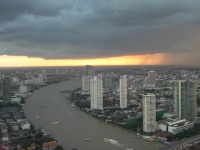 Getting Around BangkokBangkok is notorious for the huge volume of traffic and traffic
jams, but this has eased slightly over the years with the
introduction of the elevated monorail, the Skytrain, which
currently has two lines running above Bangkok''s central areas and
provides a much quicker and easier alternative to the bus. The
Bangkok Metro, established in 2004, has one route and covers areas
not connected by the Skytrain. The Metro intersects with the
Skytrain at three points and has 18 stations, with frequent
services running until midnight. The extensive bus system has
always been the main form of public transport, and they are the
cheapest, most frequent mode of travel around the city (THB 3.50 to
most destinations), but they should be used with care due to
pickpockets and bag snatchers taking advantage of the squash. The easiest, fastest and most interesting way to get around is
on the waterways of the Chao Phraya River where numerous river
taxis, long-tail boats and large waterbuses make most tourist sites
easily reachable for about THB 10. Tuk tuks (colourful
three-wheelers) are the standard way of making short journeys and
are cheaper and quicker than regular taxis, but fares should be
negotiated before boarding. Metered and un-metered taxis are
air-conditioned, but be aware that drivers don''t carry much change.
Any taxi or tuk tuk can be hired for a day''s tour of the sights
(THB 500-800). If in a desperate rush during gridlock, motorcycle
taxis can be hired, which are cheaper and faster, but passengers
will need nerves of steel, and they should only be used for short
distances. They can be recognised by the colourful, numbered vests
worn by drivers. One fun way to see Bangkok is by bicycle. The city loans free
bikes to tourists for two set routes along the river; the east side
goes past some of the biggest temples, while the west side goes
through more residential areas. be sure to ask for a bike lock so
you can stop and sightsee at the attractions along your way. |